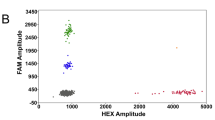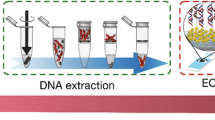Abstract
A novel PCR-free DNA-based assay was developed for the detection of Vibrio spp. A sandwich hybridization format using an immobilized capture probe and a labeled signal probe was selected and combined with chemiluminescent method for the detection of the RNA target. In a first step, probes were validated using positive controls (PCs). A linearity was observed between 0.1 and 2.5 nM of PC, and detection limit was determined as 0.1 nM. In a second step, specificity was checked by using RNA extracted from a panel of 31 environmental bacterial strains. Detection limit of 5 ng μL−1 of total fragmented RNA was obtained, and the assay allowed a good discrimination between the 21 Vibrio and the 10 non-Vibrio strains tested. Finally, the DNA-based assay was successfully applied to analysis of spiked and natural environmental samples. Stability and analysis time of the DNA-based assay were also investigated to optimize working conditions. We demonstrated that microplates can be coated beforehand with capture probe and stored at 4 °C without any buffer in wells for at least 30 days. The use of the pre-made plates enables the assay to be completed in 2 h. The developed assay appeared as an interesting tool to determine the presence of bacteria in environmental samples.






Similar content being viewed by others
References
Anzai Y, Kim H, Park JY et al (2000) Phylogenetic affiliation of the pseudomonads based on 16S rRNA sequence. Int J Syst Evol Microbiol 50:1563–1589. doi:10.1099/00207713-50-4-1563
Butot S, Putallaz T, Sanchez G (2007) Procedure for rapid concentration and detection of enteric viruses from berries and vegetables. Appl Environ Microbiol 73:186–192. doi:10.1128/AEM.01248-06
Cai T, Jiang L, Yang C, Huang K (2006) Application of real-time PCR for quantitative detection of Vibrio parahaemolyticus from seafood in eastern China. FEMS Immunology & Medical Microbiology 46:180–186. doi:10.1111/j.1574-695X.2005.00016.x
Chomczynski P, Sacchi N (2006) The single-step method of RNA isolation by acid guanidinium thiocyanate–phenol–chloroform extraction: twenty-something years on. Nat Protoc 1:581–585. doi:10.1038/nprot.2006.83
Clifford RJ, Milillo M, Prestwood J et al (2012) Detection of bacterial 16S rRNA and identification of four clinically important bacteria by real-time PCR. PLoS One 7:e48558. doi:10.1371/journal.pone.0048558
Coutard F, Pommepuy M, Loaec S, Hervio-Heath D (2005) mRNA detection by reverse transcription-PCR for monitoring viability and potential virulence in a pathogenic strain of Vibrio parahaemolyticus in viable but nonculturable state. J Appl Microbiol 98:951–961. doi:10.1111/j.1365-2672.2005.02534.x
Frahm E, Obst U (2003) Application of the fluorogenic probe technique (TaqMan PCR) to the detection of Enterococcus spp. and Escherichia coli in water samples. J Microbiol Methods 52:123–131
Frans I, Michiels CW, Bossier P et al (2011) Vibrio anguillarum as a fish pathogen: virulence factors, diagnosis and prevention: pathogen profile of Vibrio anguillarum. J Fish Dis 34:643–661. doi:10.1111/j.1365-2761.2011.01279.x
Garrido-Maestu A, Chapela M-J, Vieites JM, Cabado AG (2015) lolB gene, a valid alternative for qPCR detection of Vibrio cholerae in food and environmental samples. Food Microbiol 46:535–540. doi:10.1016/j.fm.2014.09.012
Gescher C, Metfies K, Medlin LK (2008) The ALEX CHIP—development of a DNA chip for identification and monitoring of Alexandrium. Harmful Algae 7:485–494. doi:10.1016/j.hal.2007.11.001
Goarant C, Merien F (2006) Quantification of Vibrio penaeicida, the etiological agent of Syndrome 93 in New Caledonian shrimp, by real-time PCR using SYBR Green I chemistry. J Microbiol Methods 67:27–35. doi:10.1016/j.mimet.2006.02.013
Griffitt KJ, Noriea NF, Johnson CN, Grimes DJ (2011) Enumeration of Vibrio parahaemolyticus in the viable but nonculturable state using direct plate counts and recognition of individual gene fluorescence in situ hybridization. J Microbiol Methods 85:114–118. doi:10.1016/j.mimet.2011.02.006
Huq A, Sack RB, Nizam A et al (2005) Critical factors influencing the occurrence of Vibrio cholerae in the environment of Bangladesh. Appl Environ Microbiol 71:4645–4654. doi:10.1128/AEM.71.8.4645-4654.2005
Le Roux F, Wegner KM, Baker-Austin C, et al. (2015) The emergence of Vibrio pathogens in Europe: ecology, evolution, and pathogenesis (Paris, 11–12th March 2015). Front Microbiol 6. doi:10.3389/fmicb.2015.00830
Letowski J, Brousseau R, Masson L (2004) Designing better probes: effect of probe size, mismatch position and number on hybridization in DNA oligonucleotide microarrays. J Microbiol Methods 57:269–278. doi:10.1016/j.mimet.2004.02.002
Liew PS, Lertanantawong B, Lee SY et al (2015) Electrochemical genosensor assay using lyophilized gold nanoparticles/latex microsphere label for detection of Vibrio cholerae. Talanta 139:167–173. doi:10.1016/j.talanta.2015.02.054
Low K-F, Chuenrangsikul K, Rijiravanich P et al (2012) Electrochemical genosensor for specific detection of the food-borne pathogen, Vibrio cholerae. World J Microbiol Biotechnol 28:1699–1706. doi:10.1007/s11274-011-0978-x
Lutz C, Erken M, Noorian P et al (2013) Environmental reservoirs and mechanisms of persistence of Vibrio cholerae. Front Microbiol. doi:10.3389/fmicb.2013.00375
Narracci M, Acquaviva MI, Cavallo RA (2014) Mar Piccolo of Taranto: Vibrio biodiversity in ecotoxicology approach. Environ Sci Pollut Res 21:2378–2385. doi:10.1007/s11356-013-2049-3
Okoh AI, Sibanda T, Nongogo V et al (2015) Prevalence and characterisation of non-cholerae Vibrio spp. in final effluents of wastewater treatment facilities in two districts of the Eastern Cape Province of South Africa: implications for public health. Environ Sci Pollut Res 22:2008–2017. doi:10.1007/s11356-014-3461-z
Oliveira TCRM, Barbut S, Griffiths MW (2005) Detection of Campylobacter jejuni in naturally contaminated chicken skin by melting peak analysis of amplicons in real-time PCR. Int J Food Microbiol 104:105–111. doi:10.1016/j.ijfoodmicro.2005.02.008
Oliver JD et al (2005) The viable but nonculturable state in bacteria. J Microbiol 43:93–100
Opel KL, Chung D, McCord BR (2010) A study of PCR inhibition mechanisms using real time PCR. J Forensic Sci 55:25–33. doi:10.1111/j.1556-4029.2009.01245.x
Paniel N, Baudart J (2013) Colorimetric and electrochemical genosensors for the detection of Escherichia coli DNA without amplification in seawater. Talanta 115:133–142. doi:10.1016/j.talanta.2013.04.050
Paniel N, Baudart J, Hayat A, Barthelmebs L (2013) Aptasensor and genosensor methods for detection of microbes in real world samples. Methods 64:229–240. doi:10.1016/j.ymeth.2013.07.001
Passow U (2002) Production of transparent exopolymer particles (TEP) by phyto- and bacterioplankton. Mar Ecol Prog Ser 236:1–12. doi:10.3354/meps236001
Patel MK, Ali MA, Srivastava S et al (2013) Magnesium oxide grafted carbon nanotubes based impedimetric genosensor for biomedical application. Biosens Bioelectron 50:406–413. doi:10.1016/j.bios.2013.07.006
Patel MK, Ali MA, Krishnan S et al (2015) A label-free photoluminescence genosensor using nanostructured magnesium oxide for cholera detection. Scientific Reports 5:17384. doi:10.1038/srep17384
Petton B, Boudry P, Alunno-Bruscia M, Pernet F (2015) Factors influencing disease-induced mortality of Pacific oysters Crassostrea gigas. Aquaculture Environment Interactions 6:205–222. doi:10.3354/aei00125
Pollock FJ, Morris PJ, Willis BL, Bourne DG (2010) Detection and quantification of the coral pathogen Vibrio coralliilyticus by real-time PCR with TaqMan fluorescent probes. Appl Environ Microbiol 76:5282–5286. doi:10.1128/AEM.00330-10
Romalde JL, Dieguez AL, Lasa A, Balboa S (2014) New Vibrio species associated to molluscan microbiota: a review. Front Microbiol. doi:10.3389/fmicb.2013.00413
Samain JF, McCombie H (2008) Summer mortality of Pacific oyster Crassostrea gigas. The Morest Project. Versailles: Quae Editions. 379 pp
Saulnier D, De Decker S, Haffner P (2009) Real-time PCR assay for rapid detection and quantification of Vibrio aestuarianus in oyster and seawater: a useful tool for epidemiologic studies. J Microbiol Methods 77:191–197. doi:10.1016/j.mimet.2009.01.021
Schauer S, Jakwerth S, Bliem R et al (2015) Dynamics of Vibrio cholerae abundance in Austrian saline lakes, assessed with quantitative solid-phase cytometry: V. cholerae dynamics assessed with solid phase cytometry. Environ Microbiol 17:4366–4378. doi:10.1111/1462-2920.12861
Schrader C, Schielke A, Ellerbroek L, Johne R (2012) PCR inhibitors—occurrence, properties and removal. J Appl Microbiol 113:1014–1026. doi:10.1111/j.1365-2672.2012.05384.x
Shikuma NJ, Hadfield MG (2010) Marine biofilms on submerged surfaces are a reservoir for Escherichia coli and Vibrio cholerae. Biofouling 26:39–46. doi:10.1080/08927010903282814
Tall A, Teillon A, Boisset C et al (2012) Real-time PCR optimization to identify environmental Vibrio spp. strains. J Appl Microbiol 113:361–372. doi:10.1111/j.1365-2672.2012.05350.x
Tarr CL, Patel JS, Puhr ND et al (2007) Identification of Vibrio isolates by a multiplex PCR assay and rpoB sequence determination. J Clin Microbiol 45:134–140. doi:10.1128/JCM.01544-06
Thompson JR, Randa MA, Marcelino LA et al (2004) Diversity and dynamics of a North Atlantic coastal Vibrio community. Appl Environ Microbiol 70:4103–4110. doi:10.1128/AEM.70.7.4103-4110.2004
Turner JW, Good B, Cole D, Lipp EK (2009) Plankton composition and environmental factors contribute to Vibrio seasonality. The ISME journal 3:1082–1092
Vezzulli L, Brettar I, Pezzati E et al (2012) Long-term effects of ocean warming on the prokaryotic community: evidence from the vibrios. The ISME journal 6:21–30
Vezzulli L, Pezzati E, Stauder M et al (2015) Aquatic ecology of the oyster pathogens Vibrio splendidus and Vibrio aestuarianus: ecology of Vibrio splendidus and Vibrio aestuarianus. Environ Microbiol 17:1065–1080. doi:10.1111/1462-2920.12484
Walling E, Vourey E, Ansquer D et al (2009) Vibrio nigripulchritudo monitoring and strain dynamics in shrimp pond sediments. J Appl Microbiol. doi:10.1111/j.1365-2672.2009.04601.x
Wuyts J (2004) The European ribosomal RNA database. Nucleic Acids Res 32:101D–1103. doi:10.1093/nar/gkh065
Yu CY, Ang GY, Chan KG et al (2015) Enzymatic electrochemical detection of epidemic-causing Vibrio cholerae with a disposable oligonucleotide-modified screen-printed bisensor coupled to a dry-reagent-based nucleic acid amplification assay. Biosens Bioelectron 70:282–288. doi:10.1016/j.bios.2015.03.048
Acknowledgements
Elise Da-Silva is very grateful to the University of Perpignan Via Domitia, France for its financial support through Doctoral School 305. We are thankful to the Service d’Observation du Laboratoire ARAGO for the sampling campaigns at SOLA. We also thank Christophe Canal and Léa Girard for the phytoplankton sampling at Leucate lagoon and Lisa Morales for her experimental contribution.
Author information
Authors and Affiliations
Corresponding author
Ethics declarations
All authors agreed to be listed and have approved of the manuscript, its content, and its submission to Environmental Science and Pollution Research. It has not been submitted or published elsewhere, whether partly or fully. All authors are in agreement with the ethical rules of ESPR.
Conflict of interest
The authors declare that they have no conflict of interest.
Additional information
Responsible editor: Gerald Thouand
Electronic supplementary material
ESM 1
(DOCX 37 kb)
Rights and permissions
About this article
Cite this article
Da-Silva, E., Barthelmebs, L. & Baudart, J. Development of a PCR-free DNA-based assay for the specific detection of Vibrio species in environmental samples by targeting the 16S rRNA . Environ Sci Pollut Res 24, 5690–5700 (2017). https://doi.org/10.1007/s11356-016-8193-9
Received:
Accepted:
Published:
Issue Date:
DOI: https://doi.org/10.1007/s11356-016-8193-9




